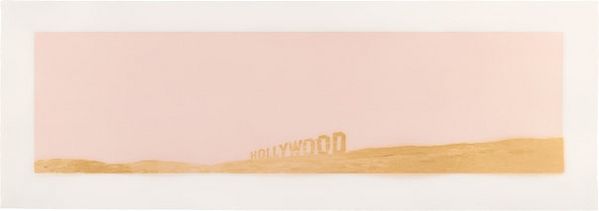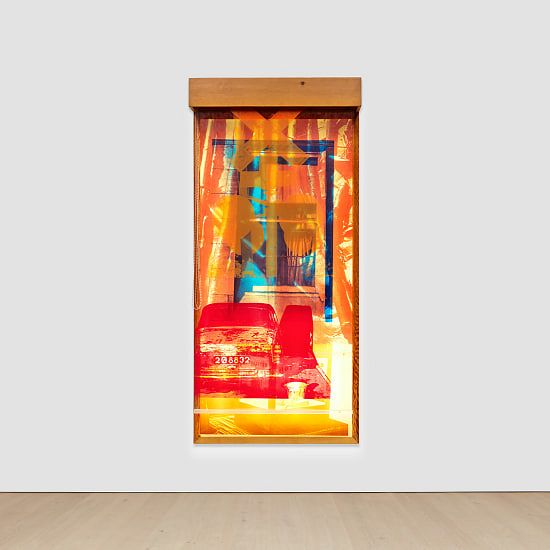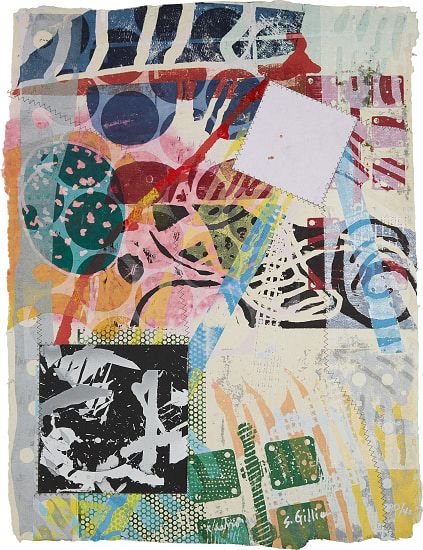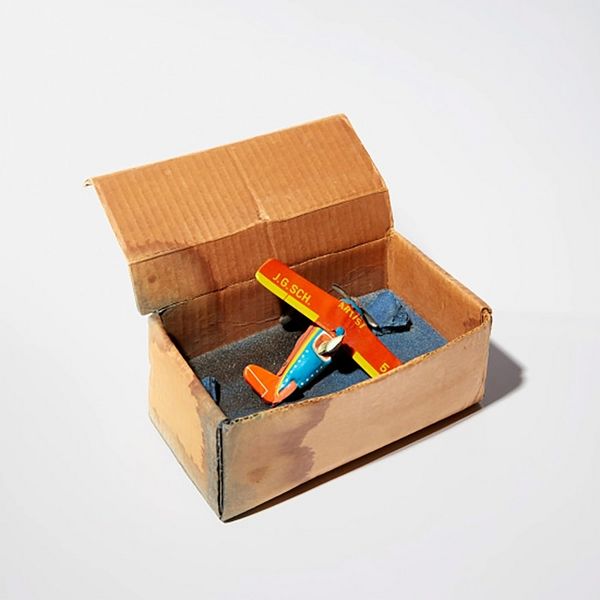Dieter Roth, Im Meer (Into the Sea), 1970. Editions & Works on Paper New York. View lot >
More than a few pieces in our Editions & Works on Paper New York Auction on 15 February 2023 go above and beyond the call of duty — a few perhaps even beyond the pale. And the stories are gorgeous.
Dieter Roth (Swiss, 1930–1998)
Swiss artist Dieter Roth is among the 20th Century’s most intriguing artists. He carries forward — as no other — the vital conceptual legacy of Marcel Duchamp and Fluxus, with his ideas continuing to fruitfully unfold even today at the nomadic Dieter Roth Academy, founded in 2000 by fifteen close friends and colleagues as a tribute to his legacy.
The magnitude of Roth’s ambition first came to light in the 1960s. After being selected for the prestigious Copley Award by jurors Marcel Duchamp, Max Ernst, and legendary anarchist poet and art critic Sir Herbert Read, among others, he launched in 1965 his magnum opus The Copley Book — a radical, semi-autobiographical deconstruction of the print-book medium. It was this vein he would continue to mine for the next several decades as the anchor for his larger conceptual practice.
Roth considered himself an itinerant artist, always on the move between cities and generating countless ideas for conceptual actions. The mini-libraries are like the chapters of his life, richly unfolding with countless inspirations. On offer in our auction are three of Roth’s signature mini-libraries of the 1970s and ‘80s. Each is a world unto itself, including compilations of the artist’s “Speedy” drawings to be unpacked and devoured over time.
Roth is also known for works he made of found materials, including ephemeral substances like rotting food. It is for this reason, he sometimes punned on his own name, calling himself “Dieter Rot.” The editioned sculpture on offer, Im Meer (Into the Sea), is a stunning exemplar from this wonderful corner of his oeuvre.
The corrugated cardboard theater of action propped open by the wing of the toy plane is characteristically biodegraded by Roth’s intention as the water-stain patina of a box long stowed away and forgotten in damp recesses of a basement. The plane has fallen, one imagines, into the sweet cast-sugar sea, a nod perhaps to youthful Phaethon, whose chariot melted when he got too close to the sun. What could be more emblematic of Roth’s anti-heroic spirit of childlike playfulness?
Ed Ruscha (American, born 1937)

Ed Ruscha, Pepto-Caviar Hollywood, 1970. Editions & Works on Paper New York. View lot >
Of all Ruscha’s Hollywood signs, Pepto-Caviar is the craziest of the bunch. The artist isn’t just alluding to the colors — he’s literally printed this edition with those materials, Pepto Bismol and Caviar. During the 1960s and ‘70s, Pepto Bismol was among most the most advertised brands on the American TV airwaves. I assume you know the slogan, “Coats, Soothes, Relieves.” Before that, in 1970 when Ruscha launched this marvelous work, it was “Coatability that spreads like a creamy blanket of relief,” which indeed makes it sound a lot like a paint.
Ruscha is famous for his words and for his landscapes. The Hollywood sign — a favorite icon in his oeuvre — combines both. He first drew it with his classic deadpan wit in 1967 as a vernacular signature of the California landscape under the all-powerful influence of the movie industry. In subsequent versions, he’s relocated the sign from midway up Mount Lee in the Beachwood Canyon to the crest of a ridge. The long and narrow, emphatic horizontal format of this image is both a witty echo of the sign’s proportions and a reference to anamorphic CinemaScope lens that dominated widescreen format shooting from 1953 to 1967.
As for the caviar, it looks to be the real thing, not just any old roe — perhaps the golden green hybrid variety from the Amur River near the border between Russia and China, which was just starting to be imported directly to California at that time. Maybe it is a simple allusion to Hollywood’s celebration of the good life — or perhaps a darker reference to the amphetamine Dexedrine, loaded into the popular, green-colored recreational drug of that era known as “Christmas trees”? That latter connection is reinforced in Ruscha’s work of that era, but also in Jacqueline Susann’s Valley of the Dolls and Russ Meyer’s Beyond the Valley of the Dolls, which released in 1970.
From 1966 on, Ruscha had begun painting typographically-inspired words that illustrated the fluid dynamics of a whole range of substances. Then, in 1969, he launched his first experiments with what are known as his “odd media,” including his Stains series edition, featuring dollops, globs, and pours of common condiments and other domestic fluids. For the 1970 Venice Biennale, he created a chocolate room of 360 sheets impregnated with the stuff (as part of a celebration of American printmaking). Ruscha carried on these explorations throughout the 70s with a wild diversity of unexpected materials, from Bolognese sauce and cherry pie to daffodils and axle grease. Pepto Bismol and caviar remain among his most inspired.
And who better to handle the technical challenge than Jean Milant coming off a two-year stint as a printer-fellow at Tamarind? Milant founded Cirrus Editions that very year, 1970. Pepto-Caviar Hollywood must have been among the very first of the many great technical challenges he was to master there. It is not for no reason that this was the heyday of printmaking in America.
Robert Rauschenberg (American, 1925–2008)

Robert Rauschenberg, Sling-Shots Lit #4, 1985. Editions & Works on Paper New York. View lot >
Rauschenberg’s Sling-Shots Lit #4 features three overlaid photo screens printed on mylar and set into a monumental lightbox — an exterior window frame, a classic European auto, and a vintage street scene focused on a roasted peanuts vendor.
The engineered pulley system invites the viewer to raise and lower these images to create an endless array of new compositional arrangements, each more cinematic than the last (i.e., figuratively speaking, you are meant to “sling the shots.”) As an object, it has presence and stature. As an experience, it’s priceless.
Rauschenberg was first exposed to the concept of interactivity by John Cage at Black Mountain College. In 1953, he participated in Cage's Theatre Piece No. 1 — considered by many to be the first-ever happening — and soon after did his first interactive piece, Music Box: a wooden box with three stones inside that, when shaken, would knock into antique nails to produce various musical notes. (Duchamp, after giving it a try, famously said, “I think I’ve heard that song before.” — but, of course, he’d heard them all.)
Three years later, in 1956, Rauschenberg created Broadcast, a painting that incorporated three working radios that the viewer could control — a concept he later built on in Oracle (1962–65), in collaboration with engineers Billy Klüver and Harold Hodges of Bell Labs. Other projects included the sculpture Dry Cell (with Hodges), which featured a voice-activated spinning metal blade, like a helicopter. Then, in 1967, Rauschenberg committed himself head-on, by cofounding with Klüver the non-profit organization Experiments in Art and Technology (E.A.T.) with a mission to arrange collaborations between artists and engineers exploring interactivity — an organization that is still vital to this day. His E.A.T. collaborations were a cornerstone of his production through the early 1970s.
The Sling-Shots Lit series that Rauschenberg commenced in 1984 signaled the rebirth of his interest in interactivity. He created six lightbox variations in all with Gemini G.E.L., running through 1985. Notably, soon after, in 1986, Rauschenberg was commissioned to do a large and important sculptural monument honoring U.S. Senator Jacob K. Javits for the main hall of the Javits Center. The Senator had been both a friend and an historically important advocate of the arts. Rauschenberg developed the idea in collaboration with Billy Klüver and Per Biorn of large rectangular panels whose movement viewers could control. The connection to the Sling-Shots Lit series is clear. Unfortunately, the architects vetoed the project, so it never saw the light of day.
Robert Rauschenberg is one of four artists currently featured in the newest installation of SITE Santa Fe, INTERPLAY, which is up through 13 February. His featured piece is Eco-Echo (1992–1993) — a sonar-activated windmill-form sculpture of moving images that comes alive when a viewer stands before it — a popular favorite. We all love his assemblages. His interactive works are more relevant than ever.
Sam Gilliam (American, 1933–2022)

Sam Gilliam, Cuatro, 1994. Editions & Works on Paper New York. View lot >
You probably know Gilliam. Maybe you don’t? He is now widely hailed as a genius like no other, for his rigorous experimentation. And the work we have on offer nails it…
Gilliam moved to Washington D.C. in 1962, at a time when Washington Color Field painters Kenneth Noland and Morris Louis (among others) were emerging in the international spotlight as the rightful heirs of Abstract Expressionism under the watchful eye of influential critic Clement Greenberg. By the end of the decade, he’d turned that movement on its head by liberating the canvas from its strict adherence to the reigning ideology of flatness. (Thank God!)
His paintings captured the feeling of the moment like no other. Ripped from the frame — even stripped of stretcher bars and structural armature of any sort — they felt like giant, free-flowing tie-dyes of pure freedom. In that era, Gilliam came to be ranked among America’s greatest Post-war painters, Pollock and Rothko, by Arne Glimcher and others, and was featured at pre-eminent museums and galleries — even representing the U.S. at the 36th Venice Biennale of 1972, curated by Walter Hopps. Despite the fact that he was African American, which didn’t help him much back then.
What always drove Gilliam was tireless experimentation. It was that that had catapulted him to his huge breakthrough. But, by 1975, it caused him to retreat from his trademark draped canvases to pursue more rigorous interrogations of color, technique, and material and this led for a time to his fall into relative obscurity — until the early decades of this century when he rightly burst into renewed and presumably everlasting prominence in the pantheon, once again.
1973 to 1975 are the years that interest us, because that’s when Gilliam first started to engage with master printmaker Bill Weege at Jones Road Press. It was to be, like Kenneth C. Tyler (Tyler Graphics) and Frank Stella, one of the most protean and fecund working relationships of all time. Gilliam stayed firmly planted in D.C., but, summers, he’d escape to Weege’s barn in Arena, Wisconsin — 40 miles west of Madison — to plunge with adventure and abandon into the possibilities of the printmaking medium for all it was worth. Weege also founded Tandem Press in 1987, with the support of UW at Madison (and Gilliam as his first client), but for their most zealous endeavors they preferred independence in the woody wilds of nature.
They did plenty of editions together but it was the monoprints that most captured their imaginations. Each edition was a living thing, requiring an epic battle plan of multiple plates and actions — sky’s the limit! — in a carefully orchestrated sequence to make it come alive, with an army of hands-on grad students in attendance, eager to learn. It was an intimate feast of making — physically robust and thoughtful all at once — and no one before or since has ever pushed the limits like this, with such keen acumen. In their 50 years working together, Ichi, Two, Tre, and Cuatro — the series they delivered in that hot summer of 1994 — are among their most paradigmatic successes.
Gilliam always looked to Miles Davis and John Coltrane as primary inspirations. These Gilliam prints are as spontaneous, vibrant, and alive as them at their absolute best. Think Miles at Lincoln Center, 1985, when the jazz crowd broke with stiff concert-hall tradition and clapped in fierce adoration at every climax.
Auction /
15 February
432 Park Ave, New York, NY, United States, 10022 (map)
Viewing /
6 – 15 February
Monday – Saturday 10am – 6pm
Sunday 12pm – 6pm
Recommended Reading
When I First Met the Queens: Iconic Warhol protégé Tama Janowitz remembers his royal portraits >
